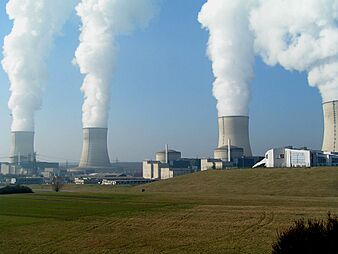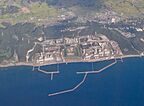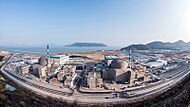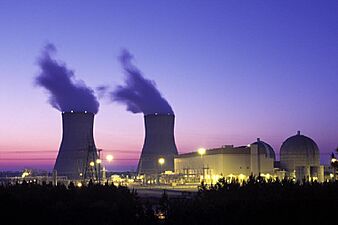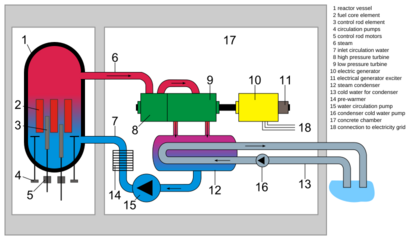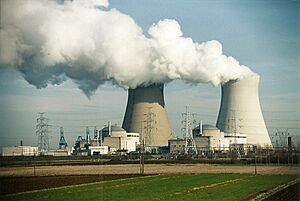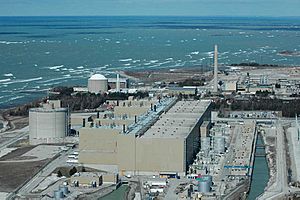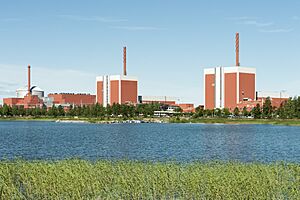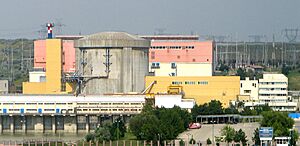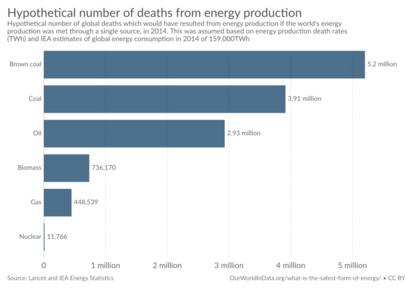Nuclear power plant facts for kids
- Cattenom Nuclear Power Plant in France
- Obninsk, the world's first nuclear power plant
- Calder Hall, the first large scale plant
- Shippingport Atomic Power Station, the US' first plant
- Kashiwazaki-Kariwa, formerly the world's largest plant
- Taishan, with the world's largest individual reactor cores
- Vogtle, the only US plant with reactors built in the 21st century
- The Chernobyl sarcophagus, built to contain the effects of the 1986 disaster
A nuclear power plant (also called a nuclear power station) is a special kind of thermal power station. It uses heat from a nuclear reactor to make electricity. Just like other power plants, this heat creates steam. The steam then spins a steam turbine, which is connected to a generator. This generator then makes electricity. As of September 2023, there were 410 nuclear power reactors working in 32 countries. Another 57 reactors were being built around the world.
Most nuclear power plants use special reactors called thermal reactors. These reactors use enriched uranium as fuel. The fuel stays in the reactor for about three years. After this, it is removed because it can no longer keep a chain reaction going. The used fuel is then cooled in special pools for several years. After cooling, it is moved to long-term storage. This used fuel is called high-level radioactive waste. Even though it's a small amount, it stays radioactive for a very long time. It needs to be kept away from people and nature for hundreds of thousands of years. But new technologies, like fast reactors, could greatly reduce this time.
Building a nuclear power plant takes a long time, often five to ten years. This can cost a lot of money. Because of these high building costs, nuclear plants are usually used to provide a steady supply of power. This helps spread out the cost of building them over many years.
Nuclear power plants produce very little carbon pollution. They are similar to renewable energy sources like solar farms and wind farms. They produce much less pollution than plants that burn fossil fuels like natural gas or coal. Nuclear power plants are also among the safest ways to make electricity. They have very few deaths from accidents or air pollution compared to other energy sources.
Contents
History of Nuclear Power
The idea of using nuclear energy for electricity started a long time ago. The very first time heat from a nuclear reactor made electricity was on December 21, 1951. This happened at the Experimental Breeder Reactor I. It was enough to power four light bulbs!
On June 27, 1954, the world's first nuclear power station started working. This was the Obninsk Nuclear Power Plant in Obninsk, in the Soviet Union. It sent electricity to a power grid for the first time. The world's first full-size power station was Calder Hall in the United Kingdom. It opened on October 17, 1956. It was also designed to make plutonium. The first full-size power station built only to make electricity was the Shippingport Atomic Power Station. This plant was in Pennsylvania, United States. It started sending power to the grid on December 18, 1957.
How a Nuclear Power Plant Works
Making electricity from nuclear power happens in a few steps. First, the nuclear reactor creates heat. This heat warms up a special liquid or gas called a coolant. The coolant then goes to a steam generator. Here, it heats water to create powerful steam. This steam then pushes a large steam turbine. The turbine spins an electrical generator, which makes electricity. After the steam has done its job, it cools down and turns back into water. This water is then pumped back to the steam generator to start the cycle again.
The nuclear reactor is the most important part of the plant. Inside its center, called the core, heat is made by splitting atoms. This process is called nuclear fission. The heat is carried away by the coolant. This energy is then used to make steam. The steam makes the turbines spin, which powers the generators.
Nuclear reactors usually use uranium as fuel. Uranium is a heavy metal found in rocks and seawater. Natural uranium has two main types, called isotopes. These are uranium-238 (U-238) and uranium-235 (U-235). U-238 makes up most of natural uranium (99.3%). U-235 makes up about 0.7%.
These different types of uranium act differently. U-235 is special because it can be easily split. When it splits, it releases a lot of energy. This makes it perfect for nuclear power. U-238 does not split easily. Different isotopes also decay at different rates. U-238 takes much longer to decay than U-235. This also means U-238 is less radioactive.
Because nuclear fission creates radiation, the reactor core is surrounded by a thick shield. This shield stops radiation from escaping. It also prevents radioactive materials from getting into the environment. Many reactors also have a strong concrete dome. This dome protects the reactor from damage, both from inside and outside.
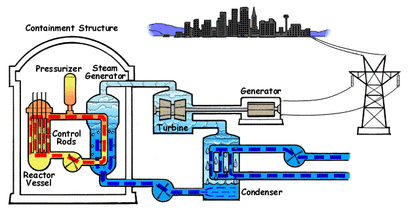
The steam turbine turns the heat from the steam into movement. The building with the steam turbine is usually separate from the main reactor building. This is to make sure that if anything goes wrong with the turbine, it won't affect the reactor.
In some reactors, like the pressurized water reactor, the steam turbine is separate from the nuclear part. This means the steam that spins the turbine is not radioactive. If there's a leak, special sensors can find it quickly. But in other reactors, like boiling water reactors, the steam that goes through the turbine is radioactive. So, the turbine area is also a controlled zone.
The electric generator changes the movement from the turbine into electricity. These are very powerful generators. A cooling system takes heat away from the reactor core. This heat is then used to make electricity. The hot coolant often heats water to make steam. This steam then drives the turbines and generators.
In an emergency, safety valves can open to prevent pipes from bursting. They also stop the reactor from exploding. These valves are designed to release steam safely. In a BWR, the steam goes into a special chamber and turns back into water.
After the steam leaves the turbine, it goes to a large cooler called a condenser. Here, the steam touches thousands of tubes with cold water flowing through them. This makes the steam turn back into liquid water. This cold water usually comes from a river or lake. The Palo Verde Nuclear Generating Station in Arizona is unique. It's in the desert and doesn't use a natural body of water for cooling. Instead, it uses treated wastewater from the Phoenix area. The water used for cooling is either sent back to its source warmer, or it goes to a cooling tower. In a cooling tower, the water cools down to be used again. Some of it evaporates into water vapor that rises out of the tower.
The feedwater system controls the water level in the steam generator and the reactor. A pump takes water from the condenser. It then increases the pressure and sends it to the steam generators (for pressurized water reactors) or directly to the reactor (for boiling water reactors).
It's very important for the plant to have a continuous power supply to stay safe. Most nuclear stations have at least two different ways to get power from outside the plant. This is for backup. These power sources usually come from different transformers and transmission lines. Also, some nuclear stations can power themselves using their own turbine generator. This means they don't need outside power while they are running.
Nuclear Power Around the World
Nuclear power plants make about 10% of the world's electricity. There are about 440 reactors working globally. They are a big source of low-carbon electricity, providing about a quarter of the world's supply in this area. In 2020, nuclear power was the second-largest source of low-carbon energy.
Nuclear power facilities are active in 32 countries. Their power also reaches other nations through shared electricity grids, especially in Europe. In 2022, nuclear power plants made 2545 terawatt-hours (TWh) of electricity. Thirteen countries got at least a quarter of their electricity from nuclear sources. For example, France gets about 70% of its electricity from nuclear energy. Ukraine, Slovakia, Belgium, and Hungary get about half their power from nuclear. Japan used to get over a quarter of its electricity from nuclear power. It is expected to return to similar levels.
Over the last 15 years, the United States has made its nuclear power plants much more efficient. They now produce as much electricity as if 19 new large reactors had been built. In France, nuclear power plants still make over 60% of the country's total power. Russia builds and exports the most nuclear power plants in the world. As of July 2023, Russia was building 19 out of 22 reactors being built by foreign companies. Meanwhile, China is building the most reactors at one time in the world, with 25 reactors under construction by late 2023.
Taking Plants Apart (Decommissioning)
Nuclear decommissioning is the process of safely taking apart a nuclear power station. It also involves cleaning up the site so that it's no longer dangerous from radiation. The main difference from taking apart other power stations is the radioactive material. This material needs special care to remove and store safely.
Decommissioning involves many steps. It includes cleaning up all radioactivity and slowly taking down the station. Once a plant is fully decommissioned, there should be no danger from radiation. People can then visit the site safely. After a facility is completely taken apart, it is no longer regulated as a nuclear site. The company that ran it is no longer responsible for its nuclear safety.
When Plants are Taken Apart
Most nuclear stations were first built to last about 30 years. Newer stations are designed to work for 40 to 60 years. Some future reactors, like the Centurion Reactor, are being designed to last 100 years.
One main reason plants get old is that the reactor's pressure vessel can get damaged over time. This happens from constant exposure to radiation. However, in 2018, a Russian company called Rosatom found a way to fix this damage. This method can make the reactor last 15 to 30 years longer.
How Flexible are Nuclear Plants?
Nuclear stations are mostly used for a steady, continuous power supply. This is because of how they are built and how much they cost. The cost of fuel for a nuclear station is less than for coal or gas plants. Since most of the cost of nuclear power plants is in building them, there isn't much money saved by running them at less than full power.
However, nuclear power plants in France are often used to adjust power output. This means they can increase or decrease how much electricity they make. This helps match the amount of electricity produced with how much people need.
Russia has been a leader in building floating nuclear power stations. These plants can be moved to different places. They can also be moved for easier decommissioning. In 2022, the United States Department of Energy started a study on offshore floating nuclear power.
Money Matters (Economics)
The cost of nuclear power plants is a big topic of discussion. Building nuclear power stations usually costs a lot of money upfront. But their daily fuel costs are low. This includes the costs of getting the fuel, processing it, using it, and storing the used fuel. So, comparing nuclear power to other ways of making electricity depends a lot on how long it takes to build them. It also depends on how the building costs are paid for. In the United States, the costs of taking apart the station and storing nuclear waste are included in the estimates.
Future reactors, called generation IV reactors, are being designed to use all the spent nuclear fuel. This would mean no waste left over. But so far, no used fuel has been fully recycled on a large scale. Most plants still store their used fuel temporarily on site. This is because it's hard to build permanent underground storage places. Only Finland has a working storage site. So, the long-term costs of waste storage are still uncertain worldwide.
Besides building costs, things like a carbon tax (a tax on carbon pollution) make nuclear power look more appealing. This is because nuclear power produces very little carbon pollution. Newer reactor designs are also expected to be more efficient and cost less to build. Generation III reactors promise to use at least 17% less fuel. Generation IV reactors aim for even better fuel use and much less nuclear waste.
In Eastern Europe, some older projects are having trouble finding money to finish building. This includes plants in Bulgaria and Romania. Some companies that were going to help pay have pulled out. When cheap natural gas is available, it also makes it harder for nuclear projects to compete.
When looking at the costs of nuclear power, it's important to know who takes the risks. In the past, governments or regulated companies built nuclear power stations. This meant that customers often paid for the risks of building costs or problems. Now, many countries have open electricity markets. In these markets, the companies building and running the plants take on more of these risks. This changes how they view the costs of new nuclear power stations.
After the 2011 Fukushima nuclear accident in Japan, costs for nuclear power plants might go up. This is because there are now stricter rules for managing used fuel and protecting against threats. However, many new designs, like the AP1000, use passive nuclear safety systems. These systems cool the reactor without needing active power. This greatly reduces the need for expensive backup safety equipment.
According to the World Nuclear Association in March 2020:
- Nuclear power is competitive with other ways of making electricity. This is true unless there is very cheap fossil fuel available.
- Fuel costs for nuclear plants are a small part of the total cost. But building costs are higher than for coal plants, and much higher than for gas plants.
- The overall costs for nuclear power (and coal and gas plants) are much lower than for energy sources that only work sometimes, like solar or wind.
- It's hard to encourage big, long-term investments in nuclear power in markets where prices change quickly. This makes it challenging to have a diverse and reliable electricity supply.
- When figuring out the costs of nuclear power, the costs of taking apart the plant and storing waste are fully included.
- Building nuclear power plants is like other big projects around the world. Their costs and challenges are often underestimated.
The Russian company Rosatom is the biggest builder of nuclear plants worldwide. While Russian oil and gas faced international rules after the 2022 invasion of Ukraine, Rosatom did not. However, some countries, especially in Europe, have stopped or canceled plans for nuclear power plants that Rosatom was going to build.
Safety and Security
Modern nuclear reactors are much safer than the first ones. A nuclear power plant cannot explode like a nuclear weapon. This is because the fuel used in reactors is not enriched enough. Nuclear weapons need very precise explosives to make the nuclear material dense enough to explode. Most reactors need to be kept cool all the time. If they get too hot, it can lead to a core meltdown. This has happened a few times due to accidents or natural disasters. When it happens, radiation is released, making the area around the plant unsafe. Plants also need to be protected from theft of nuclear material and attacks.
The most serious accidents so far were the 1979 Three Mile Island accident, the 1986 Chernobyl disaster, and the 2011 Fukushima Daiichi nuclear disaster. These happened around the time generation II reactors started working.
Some experts believe that accidents are hard to avoid in complex systems like nuclear reactors. An expert team from MIT thought that with the expected growth of nuclear power, at least four serious nuclear accidents could happen between 2005 and 2055. However, this study did not consider the safety improvements made since 1970.
Rules and Oversight
Nuclear power plants follow special rules about who is responsible if an accident happens. These rules are set by international agreements. However, many countries with nuclear power plants, like the U.S., Russia, China, and Japan, are not part of these international agreements.
- United States: In the United States, a law called the Price-Anderson Nuclear Industries Indemnity Act covers insurance for nuclear accidents.
- United Kingdom: In the United Kingdom, a law from 1965 sets the rules for nuclear damage. The company running the plant is responsible for paying for damage up to £150 million for ten years after an incident. After that, the government takes over this responsibility for up to 30 years. The government is also responsible for some costs across borders under international agreements.
Impact on the Environment
Nuclear power plants do not produce greenhouse gases while they are running. Older nuclear power plants, like those using second-generation reactors, produce about 11 grams of carbon dioxide per kilowatt-hour (g/kWh) over their whole lifetime. This is similar to wind power. It's about one-third of what solar power produces, and much less than natural gas (1/45) or coal (1/75). Newer models, like the HPR1000, produce even less carbon dioxide, as little as 1.31 g/kWh.
However, nuclear power plants do have other environmental impacts. These include radioactive waste, ionizing radiation, and waste heat. Large nuclear plants might release warm water into rivers or lakes. This can affect the plants and animals living in the water. Mining nuclear fuel like uranium can also harm the environment near the mining site. While storing nuclear waste deep underground is generally seen as safe, accidents during transport could still cause radioactive materials to leak.
Big nuclear accidents, like Chernobyl or Fukushima, release a lot of radioactive material into nature. This harms animals and people. Solutions include better safety rules and training. Also, cleaning up the accident site and creating permanent exclusion zones help reduce radiation.
What's Next for Nuclear Power
Projects Happening Now
As of March 2024, about 60 nuclear reactors are being built worldwide. They will add a total of 64 gigawatts (GW) of power. Another 110 reactors are being planned. Most of these new reactors are in Asia. In recent years, about the same number of new reactors have started working as old ones have been shut down. Over the last 20 years, 100 reactors began operations, while 107 were retired.
Next Generation Nuclear Plants
An international group is working on six new types of Generation IV nuclear reactors. This group, called the Generation IV International Forum (GIF), started in 2000. It includes 13 countries where nuclear energy is important. They share research and ideas to create new safety rules for these next-generation technologies.
In 2002, GIF chose six reactor designs after looking at about 100 ideas. These designs represent the future of nuclear energy. Three of them are fast neutron reactors. All of them will work at higher temperatures than current models. These new reactors are designed to be more sustainable, cheaper, safer, and more reliable. They are also made to resist the spread of nuclear weapons. Four designs have been tested well. They could be used commercially before 2030.
The world's first and only nuclear power plant using Gen IV reactors for commercial use is Shidao Bay Nuclear Power Plant. This plant uses a high-temperature gas-cooled reactor. It started building in 2014, began making power in 2021, and started full commercial operation in December 2023.
Fusion Power Plants
Another exciting direction for nuclear power plants is nuclear fusion. This is different from fission because it joins atoms together instead of splitting them. Scientists have made big progress in fusion research. Over 50 countries are working on it. Recently, they even achieved the first-ever scientific energy gain in a fusion experiment. Many different designs are being explored. The success of fusion energy depends on global teamwork and how fast the industry grows.
Building ITER, the largest international fusion facility, began in France in 2020. This is a big step towards showing that fusion energy can work. Experiments are set to start in the next few years, with full-power tests planned for 2036. ITER aims to prepare the way for DEMO power plants. Experts think these could be working by 2050. At the same time, private companies are also working on fusion technology. This suggests that commercial fusion power could become real even before the middle of this century. Many countries involved in the ITER project are also developing their own fusion reactor designs. In China, researchers are working on a new reactor called CFETR. Their goal is to build a practical commercial fusion power plant by 2050.
See also
 In Spanish: Central nuclear para niños
In Spanish: Central nuclear para niños
- List of commercial nuclear reactors
- List of nuclear power stations


